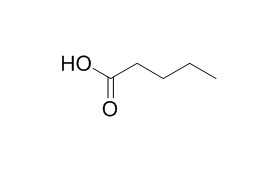Valeric acid
Reference standards.
Inquire / Order:
manager@chemfaces.com
Technical Inquiries:
service@chemfaces.com
Tel:
+86-27-84237783
Fax:
+86-27-84254680
Address:
1 Building, No. 83, CheCheng Rd., Wuhan Economic and Technological Development Zone, Wuhan, Hubei 430056, PRC
Providing storage is as stated on the product vial and the vial is kept tightly sealed, the product can be stored for up to
24 months(2-8C).
Wherever possible, you should prepare and use solutions on the same day. However, if you need to make up stock solutions in advance, we recommend that you store the solution as aliquots in tightly sealed vials at -20C. Generally, these will be useable for up to two weeks. Before use, and prior to opening the vial we recommend that you allow your product to equilibrate to room temperature for at least 1 hour.
Need more advice on solubility, usage and handling? Please email to: service@chemfaces.com
The packaging of the product may have turned upside down during transportation, resulting in the natural compounds adhering to the neck or cap of the vial. take the vial out of its packaging and gently shake to let the compounds fall to the bottom of the vial. for liquid products, centrifuge at 200-500 RPM to gather the liquid at the bottom of the vial. try to avoid loss or contamination during handling.
Int J Mol Sci.2022, 23(10):5468.
Turkish Journal of Pharmaceutical Sciences2022, DOI: 10.4274
Antioxidants (Basel).2024, 13(3):340.
Life (Basel).2022, 12(12):2107.
J Basic Clin Physiol Pharmacol.2016, 27(1):1-8
Mol Med Rep.2022, 25(1):8.
Int J Mol Sci.2023, 24(17):13230.
Research on Crops.2017, 18(3):569
Exp Mol Med.2020, 52(4):629-642.
Enzyme Microb Technol.2022, 161:110111.
Related and Featured Products
Geochimica Et Cosmochimica Acta, 2003, 67(19):3645-3664.
Experimental study of the hydrothermal reactivity of organic acids and acid anions: II. Acetic acid, acetate, and valeric acid[Reference:
WebLink]
Organic acids and acid anions occur in substantial concentrations in many aqueous geologic fluids and are thought to take part in a variety of geochemical processes ranging from the transport of metals in ore-forming fluids to the formation of natural gas to serving as a metabolic energy source for microbes in subsurface habitats.
The widespread occurrence of organic acids and their potential role in diverse geologic processes has led to numerous experimental studies of their thermal stability, yet there remain substantial gaps in our knowledge of the factors that control the rates and reaction pathways for the decomposition of these compounds under geologic conditions.
METHODS AND RESULTS:
In order to address some of these uncertainties, a series of laboratory experiments were conducted to examine the behavior of organic acids and acid anions under hydrothermal conditions in the presence of minerals. Reported here are results of experiments where aqueous solutions of acetic acid, sodium acetate, or Valeric acid (n-pentanoic acid) were heated at 325°C, 350 bars in the presence of the mineral assemblages hematite + magnetite + pyrite, pyrite + pyrrhotite + magnetite, and hematite + magnetite. The results indicate that aqueous acetic acid and acetate decompose by a combination of two reaction pathways: decarboxylation and oxidation. Both reactions are promoted by minerals, with hematite catalyzing the oxidation reaction while magnetite catalyzes decarboxylation. The oxidation reaction is much faster, so that oxidation dominates the decomposition of acetic acid and acetate when hematite is present. In contrast to previous reports that acetate decomposed more slowly than acetic acid, we found that acetate decomposed at slightly faster rates than the acid in the presence of minerals. Although longer-chain monocarboxylic acids are generally thought to decompose by decarboxylation, Valeric acid appeared to decompose primarily by “deformylation” to 1-butene plus formic acid. Subsequent decomposition of 1-butene and formic acid generated a variety of short-chain (≤C4) hydrocarbons and moncarboxylic acids as well as CO2. Valeric acid decomposition proceeded more rapidly (by a factor of 2) in the presence of hematite-magnetite-pyrite than with the other mineral assemblages, with the greater reaction rate apparently attributable to the effects of fluid chemistry. Valeric acid was observed to decompose at a substantially faster rate than acetic acid under similar conditions.
CONCLUSIONS:
The results suggest that decomposition of aqueous monocarboxylic acids may make a significant contribution to the conversion of petroleum to light hydrocarbons in natural gas and thermal fluids.



